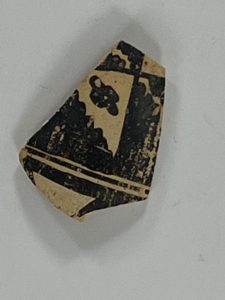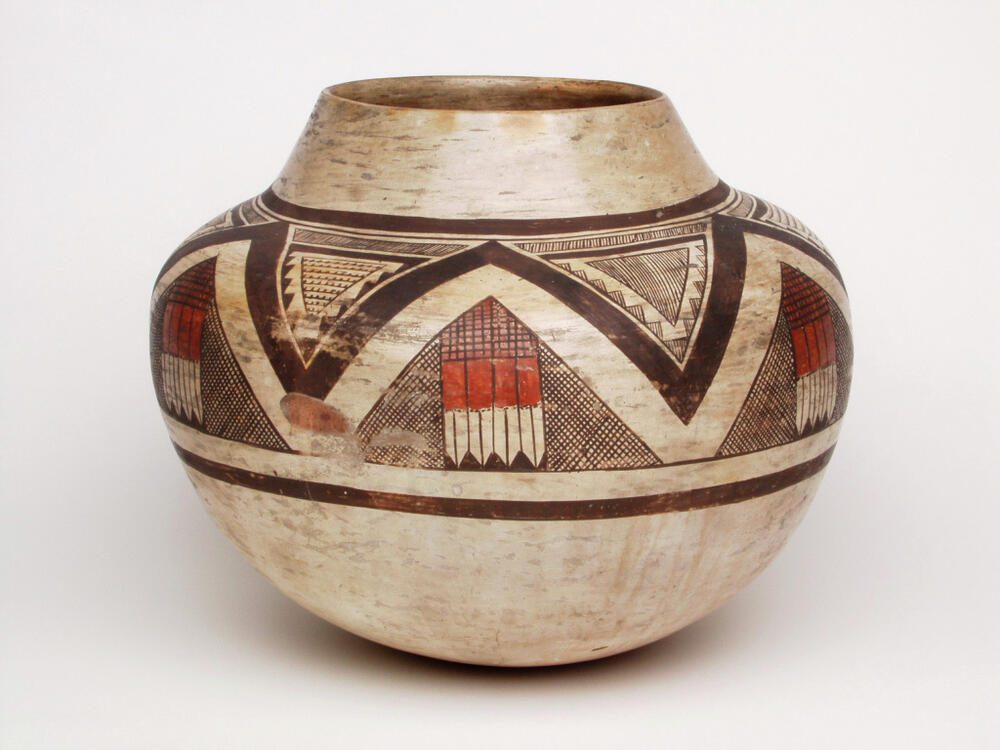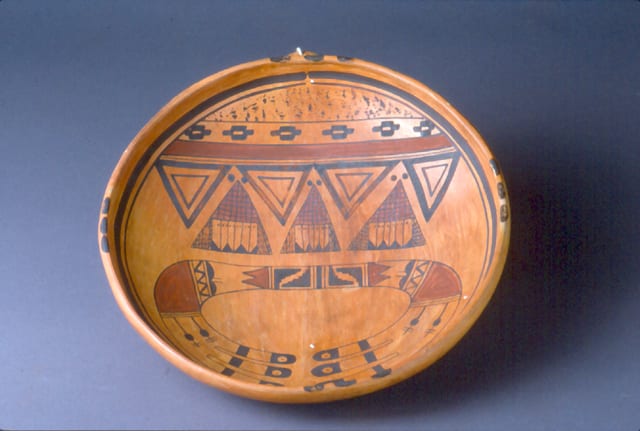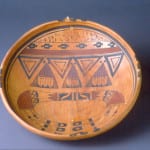Hopi Revival Ware plate attributed to Annie Healing Nampeyo, circa 1910-1920.
“The attribution of Annie is based, in part, (on) the less bold, more ‘fussy’ or ‘busy’ painting than that of her Mother, Old Lady Nampeyo,” according to Jack Isaac. Isaac traded this pot from Kent McManis of Grey Dog Trading Co. in Tucson. In an April 12, 1994 letter to me, McManis wrote: “The Hopi bowl you are purchasing originally came from a collection in Santa Fe via (my) collection in Tucson. The piece is most likely an Annie Nampeyo pot from the 1910-1920 period. The painting is much better than most pottery was at the time, yet it does not have the sweep that ‘Old Lady’ Nampeyo had in her pottery painting. Annie’s work tended to be more detailed and the design elements more crowded than her mother’s simpler and more spacious designs. Marti (Cusick) Streuver also saw a photo of the piece and agreed with my assessment. Obviously no Hopi pots were signed at the time so any assigning of artist is to some extent, guesswork. However, no other artists (except perhaps Grace Chapella, and this is not her style of design) other than Nampeyo would have been capable of this caliber of work.”
McManis and Isaac’s assessment of Annie’s design style is in line with Rick Dillingham’s comments to me on May 17, 1993 when I visited his home. At that time we discussed (and I took a picture of) an Annie Nampeyo plate in his collection. [On file.] While the layout of Rick’s plate is simpler than mine, he described the design on his plate as “fussy.” On both plates, the design figure is built of detailed, busy designs that seem to share a common artistic vision.
Based on the comments of McManis and Dillingham, I would agree that this is an Annie Nampeyo bowl. Compare the busy design of 1994-02 with the much simpler design of 1993-04 by her Mother. On 1993-04 the plain background becomes part of the design element; on 1994-02 Annie has almost covered the interior of the bowl with her designs: the remaining background does not have artistic purpose. For additional comments about the difference between “Old Lady” Nampeyo’s design style and that of her daughters, see Appendix C.
Note the band of six “4-brick” elements. Variations of this design are found on other Nampeyo/Annie bowls (cf 1996-05) and directly reflect the design appearing on shards found at the sites of ancient Hopi villages:

Annie was born about 1884 and died in 1968. See the circa 1901 four-generation photo of Nampeyo’s Mother, Nampeyo, Annie (age 17?) and her daughter Rachel in Stanislawski (1979:593). For a picture of Annie with her husband, Mother and Father and children in 1905, see Kramer (1988:51). For a picture of Annie with her mother circa 1912, see the 8 X 10 photo [on file] that I purchased from the Milwaukee Public Library.
Annie married Willie Healing in 1900, when she was about 16 years old. Her first child, Rachael Namingha, was born 3 years later. Her sixth child, Beatrice Naha, was born in 1912. It is said that after 1900 she made little pottery because of her many duties as wife and mother. Later, perhaps in the 1930’s, arthritis limited the ability of her hands. Thus pottery by Annie is rare, with much of it made early in her life before her marriage.
In the summer of 1997, I sent this bowl (and 1988-01) to Barbara Kramer for her appraisal. She provided documentary evidence that 1994-02 is indeed an Annie Nampeyo pot. The text of her letter follows:
———-
Item: Orange-slip unsigned Hopi bowl with lug and red-and-black geometric interior design.
Size: 10” diameter X 2 3/4” deep.
Description: The shallow profile of the bowl is typical of those made by Annie Healing, Nampeyo’s eldest daughter (ca. 1884-ca.1968). Four sets of three black dots are spaced equidistant around the rim of the bowl, the top set in front of the lug, the bottom offset to the right of center. A wide black framing line with a break at the top center circles the interior about 1/2” below the rim; a narrow line just beneath repeats the wider line.
A band of black stipple forms the top part of the interior design, below which is a band of six black “blossom” symbols, below which is a solid red band. Four triangular shapes, outlined by two black lines each, hang below the red band with three crosshatched triangles placed in the negative spaces between them. The hatched triangles each contain three pointed feathers. A horizontal band with black and red elements curves from the center of the interior down around both sides, ending with three black feathers on each end at the bottom center.
Condition: There are a few small pits showing white clay beneath on the interior, the rim, and the bottom, but they do not detract from the otherwise excellent condition of the bowl.
Comments: Annie began making pottery with her mother, Nampeyo, before 1900 and became an accomplished potter herself. All of her early unsigned-vessels, however, have been attributed to Nampeyo. The earliest ones that I have found directly attributed to her were collected by William R. Leigh.
The double triangular pattern described above on the interior of the bowl is very similar to the design on a jar in the collection of the Gilcrease Museum, Tulsa, cat #5437-7774. The jar was collected by artist William R. Leigh in 1912. The catalog card states ‘Made by daughter of Nam-pa-ya Tawa. 1st Mesa, Ariz. 1912’ Nampeyo’s two other daughters, Nellie and Fannie, would have been too young to have made the jar, and Leigh is known to have painted portraits of Annie, both with and without pottery.
The similarity of designs of the bowl and jar described above and the typical shallow profile of the bowl indicate that the bowl was made by Annie Healing about 1912.
Barbara Kramer (signed)
(References)
July 31, 1997
———-

Annie jar, Gilcrease Museum #54.774
This photograph is also shown in Warner (1986:181) and Wade and Cooke (2022:160). A smaller photograph of the 1912 Gilcrease pot also is reproduced in Blairs (1999:213, fig. 4.35), and the Blairs report the attribution confusion and also conclude that Annie was the painter. For other pots in the collection by Annie Healing Nampeyo, see the Artist List.


